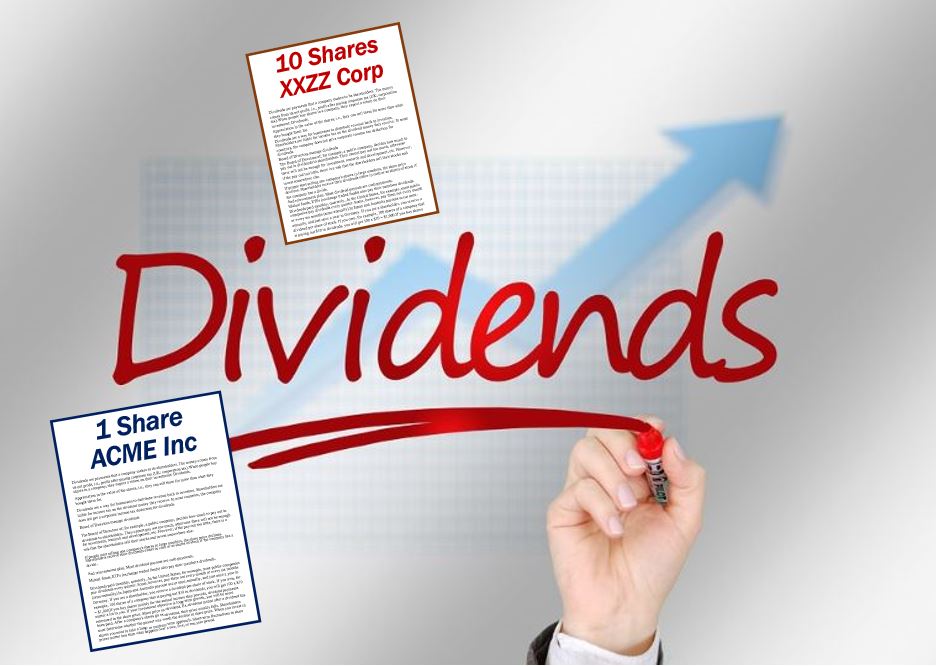Dividends are payments that a company makes to its shareholders. The money comes from its net profit, i.e., profit after paying corporate tax (UK: corporation tax).
Enhancing shareholder value, dividends reflect a company’s financial health and its commitment to sharing success with its investors.
When people buy shares in a company, they expect a return on their investment from:
- Dividends.
- Appreciation in the value of the shares, i.e., they can sell them for more than what they bought them for.
Dividends are a way for businesses to distribute revenue back to investors. Shareholders are liable for income tax on the dividend money they receive. In most countries, the company does not get a corporate income tax deduction for dividends.
Board of Directors manage dividends
The Board of Directors of, for example, a public company, decides how much to pay out in dividends to shareholders.
They cannot pay out too much, otherwise there will not be enough for investment, research and development, etc. However, if they pay out too little, there is a risk that the shareholders will sell their stocks and invest somewhere else.
If people start selling a company’s shares in large numbers, the share price declines.
Shareholders receive their dividends either in cash or as shares of stock if the company has a dividend reinvestment plan. Most payouts are cash payments.
We also use the term for regular payments to people who have invested in mutual funds and ETFs (exchanged traded funds).

Dividends paid monthly, quarterly…
In the United States, for example, most public companies pay dividends every quarter. Some, however, pay them out every month or every six months (semi-annually).
In Japan and Australia, payouts occur semi-annually, and just once a year in Germany.
If you are a shareholder, you receive a dividend per share of stock. If you own, for example, 100 shares of a company that is paying out $10 in dividends, you will get 100 x $10 = $1,000.
If you buy shares mainly for the annual income they provide, these payments matter a lot to you. If your investment objective is long-term growth, you will be more interested in the share price.
Not everybody believes that paying shareholders regularly is good for business. Wikipedia makes the following comment:
“Some believe that company profits are best re-invested in the company: research and development, capital investment, expansion, etc.”
“Proponents of this view (and thus critics of dividends per se) suggest that an eagerness to return profits to shareholders may indicate the management having run out of good ideas for the future of the company.”
Share price ex-dividend
Ex-dividend means after the shareholders have received their money. After a company’s shares go ex-dividend, their price usually falls.
Shareholders must determine whether the payout was worth the decline in share price. When you invest in shares you need to take a long- or medium-term approach. Short-term fluctuations in share prices matter less than what happens over a two, five, or ten year period.
Dividend payout ratio
The dividend payout ratio is the proportion a company pays to its stockholders in dividends from its profits. In other words, the percentage of earnings paid out to shareholders.
In the United Kingdom, the term dividend cover is more common. We calculate this ratio by dividing earnings per share by dividends per share.
Dividend price ratio
This term is also known as the dividend yield. It refers to a share’s dividend as a percentage of its price. We can also calculate it by dividing a company’s total payments to shareholders by its market capitalization.
Dividend price and payout ratios are the most commonly used ratios that shareholders calculate.
Dutch East India Company
In the 17th century, the Dutch East India Company (Vereenigde Oostindische Compagnie – VOC) was the first company to pay regular dividends. For nearly 200 years, its payments to shareholders were worth approximately 18% of share value every year.
Today’s dividend-paying entities, ranging from established corporations to modern tech startups, have adopted varied strategies for profit distribution, reflecting their unique growth trajectories and market conditions.
